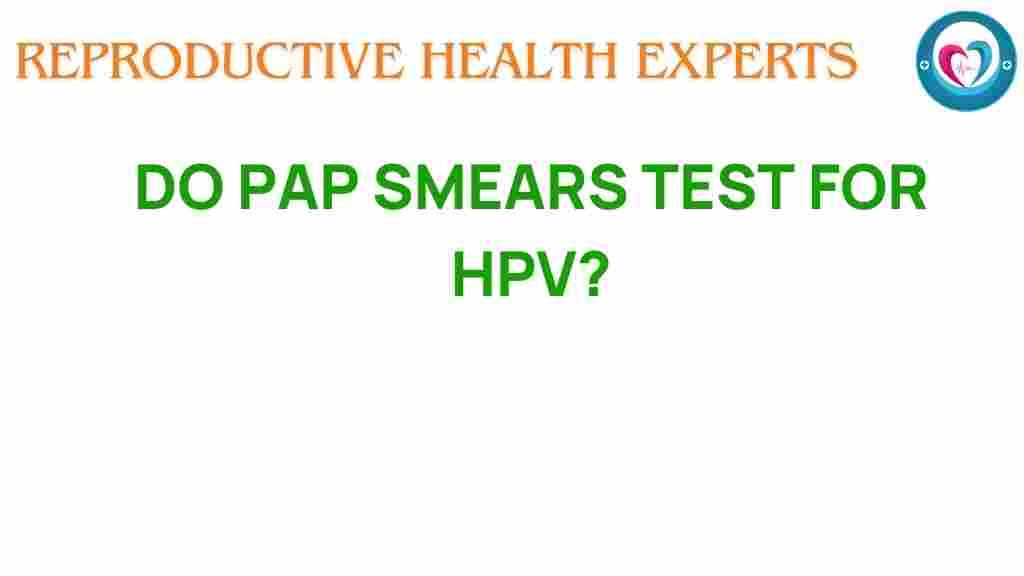Unraveling the Mystery: Do Pap Smears Test for HPV?
When it comes to women’s health, understanding the relationship between Pap smears and HPV (Human Papillomavirus) is crucial. As a vital part of routine gynecological exams, Pap smears play a significant role in screening for cervical cancer. However, many women are left wondering: do Pap smears actually test for HPV? In this article, we will explore the connection between Pap smears, HPV, and the importance of early detection in the prevention of cervical cancer.
Understanding Pap Smears
A Pap smear, also known as a Pap test, is a procedure that involves collecting cells from the cervix to check for abnormalities. This test is primarily used to detect precancerous changes in cervical cells that could lead to cervical cancer. Regular Pap smears are recommended for women starting at age 21, regardless of sexual history.
The Role of HPV in Cervical Cancer
HPV is a group of more than 200 related viruses, with over 40 types that can infect the genital area. Some types of HPV can lead to cervical cancer, making it essential for women to understand their HPV status. HPV is a common sexually transmitted infection, and while most infections resolve on their own, persistent infections with high-risk HPV types can lead to cervical cancer over time.
Do Pap Smears Test for HPV?
The answer is both yes and no. Traditional Pap smears do not test for HPV directly. Instead, they focus on identifying abnormal cervical cells. However, the HPV test can be performed alongside a Pap smear, which provides a more comprehensive screening approach.
Here’s how it works:
- Pap Smear Alone: A Pap test screens for changes in cervical cells. If abnormal cells are found, further testing may be required.
- HPV Testing: This test checks for the presence of high-risk HPV types that are most likely to cause cervical cancer. It can be done at the same time as the Pap smear.
The Importance of Co-Testing
Co-testing, which includes both Pap smear and HPV testing, is recommended for women aged 30 to 65. This dual approach enhances screening accuracy and helps in early detection of cervical cancer. The combination of both tests can lead to:
- Better identification of women at risk for cervical cancer.
- More informed decisions regarding follow-up care and treatment.
- Increased effectiveness in preventing cervical cancer.
When Should You Get Screened?
The guidelines for cervical cancer screening are as follows:
- Women aged 21-29: Pap smear every 3 years.
- Women aged 30-65: Pap smear plus HPV testing every 5 years (preferred) or Pap smear alone every 3 years.
- Women over 65: May stop screening if previous tests have been normal.
It’s essential for women to discuss their individual risk factors with their healthcare provider to determine the best screening schedule.
What to Expect During a Pap Smear and HPV Test
Understanding what happens during a Pap smear and HPV test can help alleviate anxiety. Here’s a step-by-step process:
- Preparation: Your healthcare provider will ask you about your medical history and any symptoms you may have.
- Positioning: You will lie on an examination table and place your feet in stirrups.
- Speculum Insertion: A speculum will be gently inserted into your vagina to allow access to the cervix.
- Cell Collection: Your doctor will use a small brush or spatula to collect cells from the cervix.
- HPV Testing (if applicable): If HPV testing is being done, a sample will be taken from the same cervical cells.
- Completion: The procedure typically lasts only a few minutes, after which you can resume normal activities.
Possible Side Effects and Troubleshooting
While a Pap smear and HPV test are generally safe, some women may experience mild discomfort or cramping during the procedure. Here are some troubleshooting tips:
- Discomfort: Inform your healthcare provider if you feel significant pain during the test. They may adjust the speculum or technique.
- Timing: Schedule your Pap smear when you are not on your menstrual period, as this can affect the results.
- Relaxation Techniques: Practice deep breathing or visualization to help calm any anxiety before the exam.
Understanding Your Results
After your Pap smear and HPV test, your healthcare provider will discuss the results with you. Here’s what you need to know:
- Normal Results: If both tests are normal, you can continue with routine screenings.
- Abnormal Pap Results: If your Pap results are abnormal, your doctor may recommend further testing, such as a colposcopy, to investigate the cells more closely.
- Positive HPV Results: If HPV is detected, your doctor will guide you on the next steps, which may include more frequent monitoring.
Preventing Cervical Cancer
Prevention is key in the fight against cervical cancer. Here are some essential strategies:
- Regular Screenings: Stay on top of your Pap smear and HPV testing schedule.
- HPV Vaccination: The HPV vaccine is effective in preventing the types of HPV that cause cervical cancer. It is recommended for preteens but can also be given to young adults.
- Safe Practices: Use condoms and engage in safe sexual practices to reduce the risk of HPV transmission.
Conclusion
Understanding the relationship between Pap smears and HPV is vital for all women. Regular screenings not only help in early detection but also play a significant role in the prevention of cervical cancer. By staying informed and proactive about your gynecological health, you can take control of your well-being. If you have any questions or concerns about your screenings or HPV, don’t hesitate to consult your healthcare provider.
For more information on women’s health and screenings, you can visit this resource. Additionally, if you’re interested in learning more about HPV and its prevention, check out this article.
This article is in the category Prevention and created by ReproductiveHealthExperts Team
